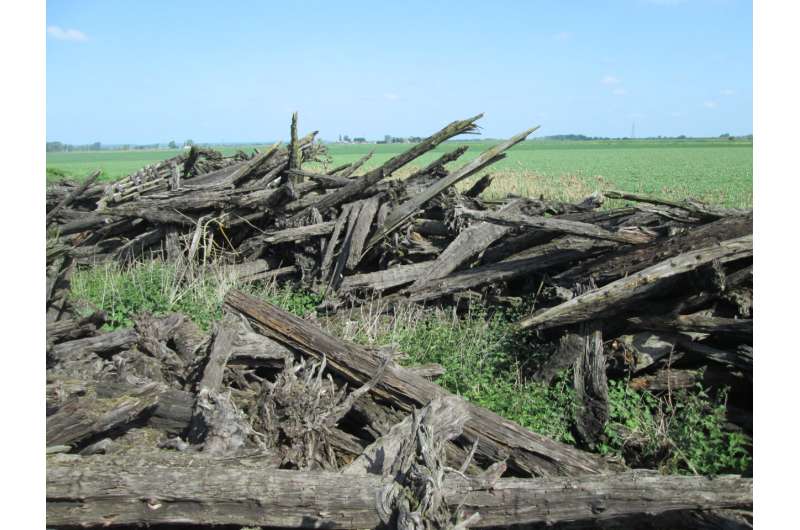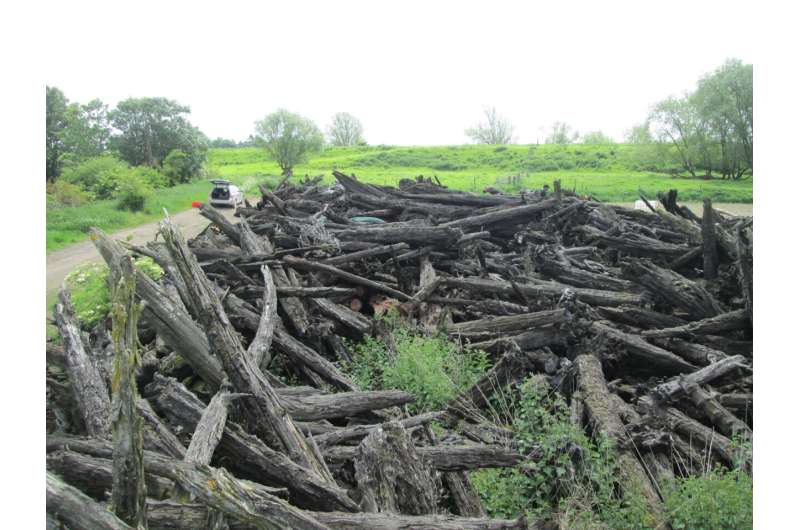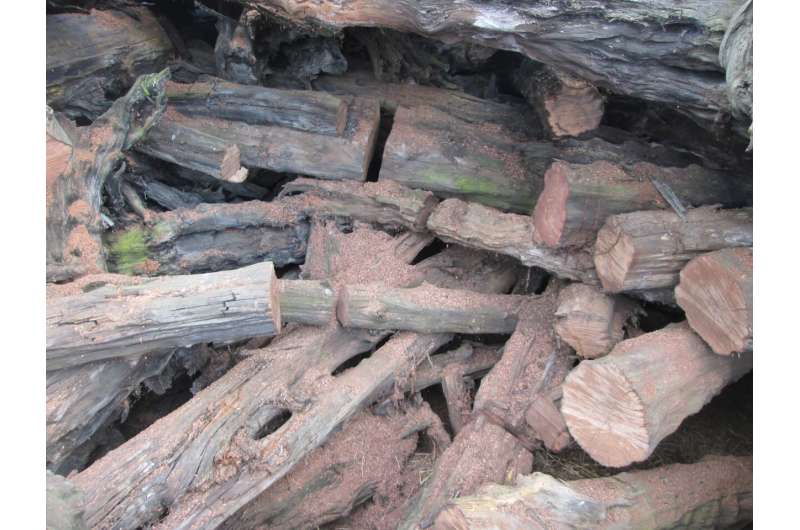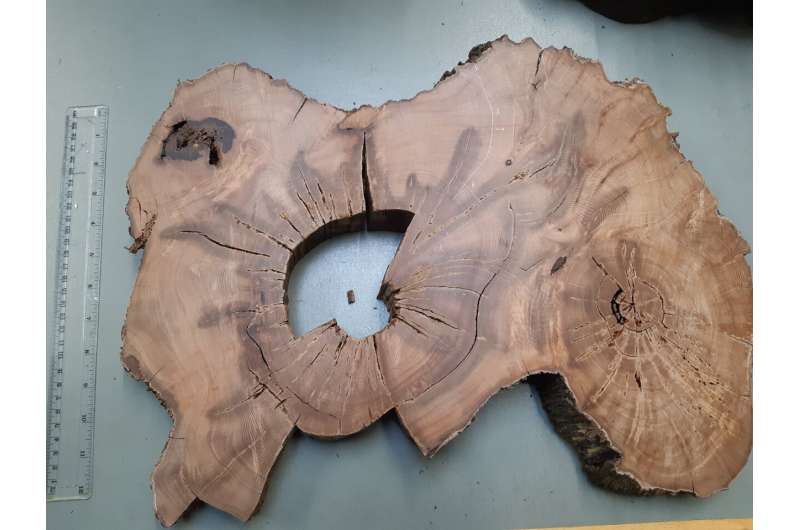This article has been reviewed according to Science X's editorial process and policies. Editors have highlighted the following attributes while ensuring the content's credibility:
fact-checked
peer-reviewed publication
trusted source
proofread
The flat Fens of eastern England once held vast woodlands, study finds

The Fens of eastern England, a low-lying, extremely flat landscape dominated by agricultural fields, was once a vast woodland filled with huge yew trees, according to new research.
Scientists from the University of Cambridge studied hundreds of tree trunks, dug up by Fenland farmers while plowing their fields. The team found that most of the ancient wood came from yew trees that populated the area between 4,000 and 5,000 years ago.
These trees, which are a nuisance when they jam farming equipment during plowing, contain a treasure trove of perfectly preserved information about what the Fens looked like thousands of years ago.
The Fen yew woodlands suddenly died about 4,200 years ago, when the trees fell into peat and were preserved. The researchers hypothesize that a rapid sea level rise in the North Sea flooded the area with salt water, causing the vast woodlands to disappear.
The climate and environmental information these trees contain could be a valuable clue in determining whether this climate event could be related to other events that happened elsewhere in the world at the same time, including a megadrought in the Middle East that may have been a factor in the collapse of ancient Egypt's Old Kingdom. The researchers have published their findings in Quaternary Science Reviews.

Yew trees (Taxus baccata) are one of the longest-lived species in Europe, and can reach up to 20 meters in height. While these trees are fairly common in Cambridge College gardens and churchyards across southern England, they are absent in the Fens, the low-lying marshy region of eastern England. Much of the Fens was a wetland until it was drained between the 17th and 19th centuries using artificial drainage and flood protection. Today, the area is some of the most productive farmland in the U.K., thanks to its rich peat soil.
While the area is great for farming and does have its own charms, few people would describe the Fens as spectacular: for the most part, the area is extremely flat and dominated by fields of potatoes, sugar beet, wheat and other crops. But 5,000 years ago, the area was a huge forest.
"A common annoyance for Fenland farmers is getting their equipment caught on big pieces of wood buried in the soil, which can often happen when planting potatoes, since they are planted a little deeper than other crops," said lead author Tatiana Bebchuk, a Ph.D. student from Cambridge's Department of Geography. "This wood is often pulled up and piled at the edge of fields: it's a pretty common sight to see these huge piles of logs when driving through the area."
For farmers, these logs are a nuisance. But for Bebchuk and her colleagues, they are buried treasure. The Cambridge team approached several Fenland farmers and took samples of hundreds of logs that had been dug up and discarded, to find out what secrets they might hold.

"I remember when I first saw this enormous pile of abandoned trees, it was incredible just how many there were," said Bebchuk. "But when we got them back to lab, we were even more surprised: these trees were so well-preserved, it looked as if they were cut down just yesterday."
To put current anthropogenic climate change in a long-term context of natural variability, scientists need accurate evidence from the past, and trees are some of the best recorders of past conditions: their annual growth rings contain information about temperature and hydroclimate for every growing season they witnessed. "But the further back in time we go, the less reliable evidence we have, since very old trees and well-preserved wood materials are extremely rare," said Professor Ulf Büntgen, the senior author of the study.
However, analysis by the Cambridge Tree-Ring Unit (TRU) showed that the yew trees dug up from Fenland fields were very old indeed: some of these ancient trees were 400 years old when they died. The new find provides unique climate information for over a millennium from around 5,200 years ago until about 4,200 years ago, when much of the Fens was a woodland of yew and oak: completely different than it looks today.
"Finding these very old trees in the Fens is completely unexpected—it would be like turning a corner in rural Cambridgeshire and seeing an Egyptian pyramid—you just wouldn't expect it," said Bebchuk. "It's the same with nature—wood rots and decomposes easily, so you just don't expect a tree that died 5,000 or 4,000 years ago to last so long."

Given that most of the Fens are barely above sea level, about 4,200 years ago, a sudden rise in sea level most likely killed the Fen woodlands. The period that the Fen woodlands died coincided with major climatic changes elsewhere in the world: at roughly the same time, a megadrought in China and the Middle East was a possible trigger of the collapse of several civilizations, including Egypt's Old Kingdom and the Akkadian Empire in Mesopotamia.
"We want to know if there is any link between these climatic events," said Bebchuk. "Are the megadroughts in Asia and the Middle East possibly related to the rapid sea level rise in northern Europe? Was this a global climate event, or was it a series of unrelated regional changes? We don't yet know what could have caused these climate events, but these trees could be an important part of solving this detective story."
"This is such a unique climate and environmental archive that will provide lots of opportunities for future studies, and it's right from Cambridge's own backyard," said Büntgen. "We often travel all over the world to collect ice cores or ancient trees, but it's really special to find such a unique archive so close to the office."
More information: Sudden disappearance of yew (Taxus baccata) woodlands from eastern England coincides with a possible climate event around 4.2 ka ago, Quaternary Science Reviews (2023). DOI: 10.1016/j.quascirev.2023.108414
Journal information: Quaternary Science Reviews
Provided by University of Cambridge




















